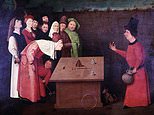Rachel Morris’s latest work, *The Years Of The Wizard*, delves into the fascinating world of magicians during the Elizabethan era, exploring the belief systems and practices that shaped this intriguing period of British history. Released in September 2025, the book examines the lives of notable figures such as *John Dee*, a prominent magician and adviser to *Elizabeth I*, who combined astrology, alchemy, and mysticism in his work.
Morris begins by recounting the story of *John Damian*, a historical figure who served as an alchemist to *James IV of Scotland*. Damian’s attempts to fly from the ramparts of *Stirling Castle* using wings he constructed himself ended in a broken thigh. This incident, while seemingly absurd by today’s standards, reflects the era’s acceptance of experimentation and belief in the extraordinary.
In the context of the 16th century, figures like *Dee* were not only respected for their knowledge but were also seen as essential contributors to scientific exploration. Dee, for example, is credited with providing mathematical calculations that enabled sailors to navigate to the New World. His pursuits included not just alchemy but also dream interpretations and astrological readings. Today, his crystal ball and black obsidian mirror are displayed in the *British Museum*, a testament to his lasting influence.
Astrology and Alchemy: The Fabric of Elizabethan Magic
The beliefs held by magicians of this era were diverse and often intertwined with the prevailing scientific ideas. Wizards operated under the conviction that astrology played a significant role in human affairs, while alchemical pursuits aimed to transform base metals into gold. Morris outlines various practices, such as the use of a ‘sieve and shears’—a method where questions were posed to a sieve held between scissors, allowing it to turn and provide answers. Higher-ranking wizards engaged in such elaborate methods, while the less affluent consulted ‘cunning folk’ for simpler potions and charms.
Morris also reflects on how widespread fairy tales and folklore influenced public perception of magic. The allure of control over fate, as illustrated by the ‘celestial globe’—a device that allowed users to manipulate a representation of the stars—captivated the imagination of many, leading them to embrace what might now be seen as superstition.
While recounting these historical narratives, Morris raises intriguing questions about the motivations behind these magical practices. Was *Edward Kelley*, Dee’s scryer, genuinely communicating with angels, or was he merely exploiting Dee’s credulity for financial gain? There is a suggestion that Kelley might have been under the influence of drugs or suffering from mental instability, leaving readers to ponder the authenticity of their interactions.
Debunking Myths: The Fine Line Between Magic and Trickery
Morris’s exploration extends to other figures such as *Heinrich Cornelius Agrippa*, who was known for his dubious magical prowess. Anecdotes of him paying tavern bills with coins that transformed from gold to horn raise the question: were these instances genuine displays of wizardry, or well-executed tricks? This ambiguity is central to understanding how magic was perceived and practiced during this age.
As Morris presents her findings, she invites readers to reconsider the nature of belief in magic. The motivations of magicians, from their pursuit of knowledge to their desire for monetary gain, highlight the complex relationship between science, mysticism, and the human experience. The book not only recounts historical events but also prompts a deeper reflection on the societal context in which these beliefs flourished.
*The Years Of The Wizard* is now available through various retailers, providing a comprehensive look at the great British magicians who shaped an era defined by curiosity, belief, and the quest for understanding. Morris’s work serves as a reminder of the thin line between reality and illusion, a theme that continues to resonate in contemporary discussions about science and mysticism.







